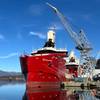This Safety Alert addresses safety issues relating to air receivers on Uninspected Towing Vessels (UTV), but may apply to air receivers on any vessel. Air receivers, regardless of specific use onboard a UTV, contain extreme amounts of potential energy; an uncontrolled release of this energy may lead to serious injury, death and catastrophic vessel damage. Although this issue involves basic safety and good marine practice, too many related problems have been recently discovered.
Not long ago, an air receiver unexpectedly ruptured with terrible results onboard an UTV on the Upper Mississippi River. A crewmember was seriously injured and paralyzed. Several causal factors were noted during the casualty investigation; the lack of a relief valve to protect the system and significant corrosion within the receiver. It’s important to note that on unprotected systems, all it takes for the system to be over-pressurized is for the compressor’s pressure switch/contactor or unloader to fail and not shut off the machine. Further, internal corrosion on aged tanks present a latent unsafe condition and may go unnoticed if not inspected. (Parted air receiver.)
As a result of this casualty and other similar incidents, the U. S. Coast Guard strongly recommends that UTV Owner/Operators, vessel engineers, insurance surveyors and other inspectors ensure that:
• A proper sized pressure relief device is installed on all air receivers. The pressure relief device should not be rated higher than the Maximum Allowed Working Pressure (MAWP) stamped on the air receiver’s data plate;
• A data plate is attached to the receiver and pressure relief devices. If missing or damaged the UTV representative should provide evidence to prove the components were constructed to an approved standard. Otherwise this equipment should be taken out of service or replaced;
• The data plate associated with the receiver and pressure relief device remain unpainted and legible. Take care to minimize damage to the plates if paint needs to be removed. Pressure relief devices should not be painted as paint can interfere with the lifting of the valve. Those that are painted should be lift tested to ensure proper operation;
• Pressure relief devices are not capable of being isolated or their operation prevented by being wired or secured in a position that prevents the valve from opening;
RELIEF VALVES MUST NEVER BE SECURED IN THE CLOSED POSITION
• Each receiver is equipped with a drain valve to remove condensate and all crewmembers making rounds in the machinery space are instructed to drain the condensate as part of their regular machinery space duties;
• All repairs and alterations to air receivers and pressure relief devices are conducted by companies holding the National Board of Boiler and Pressure Vessel “R” Certificate for air receivers and the “VR” Certificate for pressure relief devices; and
• Owner/Operators establish maintenance programs based on the manufacturer’s recommendations for such equipment that includes routine internal and external receiver inspections. External inspections should include surface examinations for evidence of deterioration such as cracks, blisters, corrosion erosion, dents, etc., with particular attention to the support attachments and welds.
Owner/Operators should be aware of these potential safety hazards and take proper action as needed. Failure to address these concerns could result in a hazardous condition, and the Coast Guard determining Operational Controls are necessary. If in doubt, contact your local Coast Guard office or the Towing Vessel National Center of Expertise at (270) 444-7715.
This safety alert is provided for informational purposes only and does not relieve any domestic or international safety, operational or material requirement. Developed by the Towing Vessel National Center of Expertise. Distributed by the U.S.C.G. Headquarters Office of Investigations and Analysis, Washington, DC. Questions may be addressed to
[email protected].














